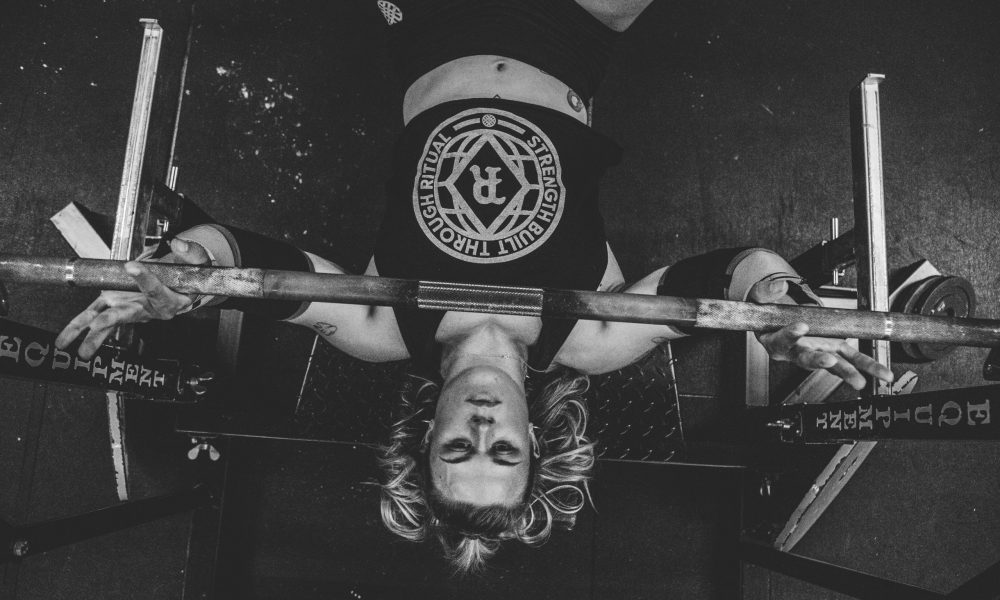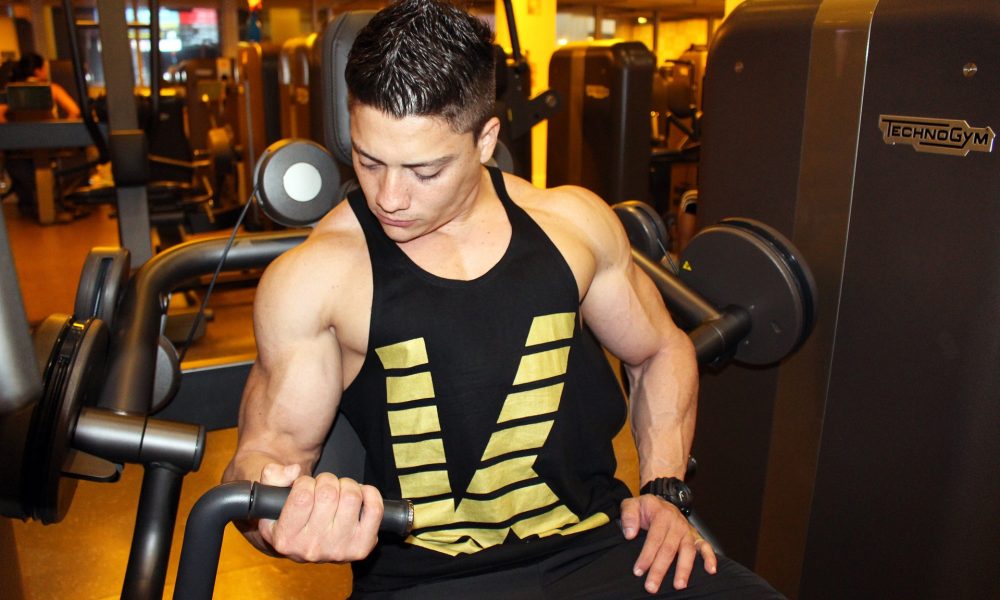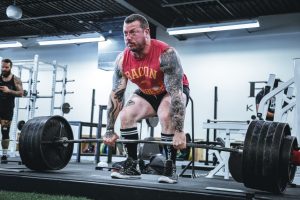
Keys to Dieting Consistency and Success
You could know everything about food like a wizard and have the most science proven diet in place, but if you can’t stick to that style of eating consistently, you won’t see any results. Period.

The training to failure debate rages on as bros, lifting nerds, and coaches just can’t seem to agree on this topic.
There’s an endless stream of articles, posts, and discussion on this topic, but very little substance. Lots of quantity, but very little quality because every dork and influencer on the internet wants to have an opinion.
Here are the 2 sides of the spectrum.
On one end, you have people who generally think lifting to failure is best to maximize hypertrophy because each set is so much more stimulating and really forces the body to adapt/remodel, all without the additional fatigue from having to do too many sets.
On the other end, you have people who generally think staying a little short of failure is best to maximize hypertrophy because you can get a more favorable stimulus to fatigue ratio each set, recover better, and are able to do additional volume in the session and during the week.
This is a slight oversimplification and there are obviously many people somewhere in between, but we need the sides defined clearly if we are going to have a productive discussion.
In a world with so much division, here are a few things both tribes can agree on. These are indisputable and highly relevant, so we might as well get these out of the way first.
First off, for building maximal strength, training to failure is not optimal (1-3). To get stronger at a lift, you’re essentially getting more skilled at that lift. Specific practice is key, not necessarily high-tension fiber splitting intensity (28).
This is why strength building comes down to practicing a lot of high-quality reps. The final reps before failure are generally unnecessary and even detrimental for building strength. They’re deeply fatiguing leading to significant velocity loss (28). You’re essentially doing extra reps that don’t reinforce optimal bar acceleration while getting more worn down.
The additional fatigue also reduces subsequent volume/load within the session and compromises training frequency across the week, all of which are crucial factors for building strength.
This is why powerlifters generally don’t train to failure. They train very heavy, but they don’t train to the brink of failure (at least not for a majority of sets). This allows them to practice movements at a higher bar speed more often (19).
Returning back to the topic of hypertrophy, there might be controversy between failure vs non-failure, but we can all agree you have to at least train close to failure on all working sets or else you’re significantly shortchanging yourself (4).

There needs to be sufficient tension and effort with each set, so getting to at least 4 reps in reserve is crucial. This seems rather obvious, but many lifters don’t train hard at all.
Many lifters think they’ll end a set at only 2 reps away from failure when in reality they had like 6 more reps in reserve (especially on higher rep sets). In beginner lifters, research shows on average, they’re ending sets 6 reps shy of their targeted failure point (17).
Advanced lifters aren’t innocent either. Research shows even they tend to also underestimate their reps in reserve especially in females (18,29). However, advanced lifters are pretty accurate with lower rep sets thanks to being less painful (26).
From my experience, many newer/intermediate folks simply don’t know what getting close to failure feels/looks like. They often wimp out their sets way too early to avoid the gnarly pain of those final reps.
True failure means the concentric portion of the lift cannot be completed no matter how hard you contract with good form. This means during a set, the concentric tempo should eventually slow down as fatigue accumulates until the rep fails or you don’t attempt another rep because you would confidently bet your life the next rep would fail.
That’s what true failure looks like and even stopping just a bit short should feel brutal.
This small section is honestly the most applicable part for a majority of readers. Most people don’t need to worry about the deep nuances I’m about to discuss between failure training vs stopping just a tad short. Most people just need to work on actually getting close to failure in the first place and not stopping their set at like 8 reps in reserve.
Alright, now we got that out of the way, let’s discuss the controversy between failure training vs non-failure training (stopping just a bit short at about 1-3 reps in reserve) for maximizing hypertrophy.
We already covered, that you must train hard, but the big argument lies in the very final reps before complete failure. Are those very final reps critical for hypertrophy or are they simply not worth the fatigue?
Research does show training to failure remarkably increases the time course for recovery (5). It also increases metabolic stress and blood pressure exponentially in those final reps (31,32).
In strength trained individuals, 4 sets to failure produced sustained fatigue in it’s respective movement 24 hours later while 5 sets performed 2 reps shy of failure didn’t (27). In fact, a recent review found all markers of recovery and muscle damage are more unfavorable when training to failure even when total reps are matched (33).
Furthermore, training to failure allows for additional repetitions in the initial set, but due to disproportionate fatigue, there is a bigger drop off in reps in the subsequent sets.
One study found training to failure vs stopping a bit short both lead to the same volume load after 4 working sets, but the non-failure group had better rep velocity and less fatigue/discomfort (6).
That said, let’s take a closer look at studies measuring actual muscle growth. We’ll start with beginner studies before moving on to studies in advanced lifters.
Goto et al 2005 is a garbage study that everybody quotes. It essentially compared warm up sets with failure sets (7). It’s not comparing what we want to discover which is failure vs stopping just a bit short.
Martorelli et al 2017 is also a garbage study for the same reason (3). The non-failure group was forced to stop way too far from failure along with other issues I won’t get into.
However, not all study designs suck. Sampson et al 2016 and Nobrega et al 2018 are much better designed (8,9). Both of them showed the same thing, muscle growth was similar between failure and stopping a bit short in beginner lifters doing isolation exercises.
Next is Lacerda et al 2019 which compared each subject’s leg separately using leg extensions (20). One leg trained 3-4 sets to failure while the other leg did the same set volume, but stopped a few reps shy of failure by training with the average sum of reps the failure leg did. So if the failure set did 10, 8, 6, the non-failure leg would do 8, 8, 8. Muscle growth was similar between groups, but trends favored the non-failure leg.
Terada et al 2020 found the opposite trend (25). However, the non-failure subjects at times were lifting as far as 6 reps away from the failure group which technically didn’t lift to failure anyways.
Then we have Lasevicius et al 2019 which is a pretty garbage study (21). They compared 4 different conditions using leg extensions, but the 2 non-failure groups trained way far from failure. The high-load non-failure group was about 7 reps away from failure yet still got comparable growth while the low-load non-failure group were like 15 reps away from failure.
For newer lifters, it’s conclusive that you don’t need to train all the way to failure especially considering you haven’t adapted to more experienced recovery capabilities. Your growth will be comparable if not better with stopping just a bit shy of failure.
Grab my Lifter’s Guide to Managing Stress
Pareja-Blanco et al 2016 compared two groups training 6 sets of smith machine squats split across 2 workouts per week (10). One group terminated their sets at 20% velocity loss and one group terminated their sets at 40% velocity loss causing half of their sets to reach failure.
The 20% group trained pretty far from failure most sets while never truly reaching failure. The 40% was able to accumulate significantly more total reps.
Despite this, muscle growth was statistically similar although effect sizes did favor the 40% group. This study shows us as best, failure might be a bit better with lower training volumes, but probably isn’t worth it or beneficial at higher training volumes.
Pareja-Blanco et al replicated this study in 2020 with free squats where the 40% group lifted every set about 3 reps closer to failure (22). This study had the opposite results.
They did another replication with both groups going a bit closer to failure (25 vs 50% velocity loss). This study found no difference in hypertrophy (23). Andersen et al found had the same results in a similar study (30).
Next is GieBsing et al 2016 and no, that’s not a typo (11). The author just has a funky last name with a capital B randomly in the middle of it. Unfortunately, his study didn’t make him look any better because it was utter garbage. It found training to failure produced more muscle growth, but the non-failure group trained way far from failure. Furthermore, this study used a training volume of 1 set per workout in 2 workouts per week. Who even trains like that?

Next is Helms et al 2018, a better study which compared 2 groups lifting the exact same reps and sets (12). One group’s load were fixed 1-RM percentages while the other group got to select their load based on RPE.
The RPE group consistently trained a little closer to failure due to their load selection, but muscle growth was similar between groups.
Next is Karsten et al 2019 which is a garbage study (13). The non-failure group was training way far from failure especially considering human underestimations (14). Despite this, only quad growth was statistically superior for the failure group. Bicep and shoulder growth were statistically similar between groups, but the effect sizes favored the non-failure group for shoulders.
Next is Carroll et al 2019 which is probably the best failure study up till 2019 in trained subjects (15). Both the failure and non-failure group had an identical training program matching in reps/sets. However, the failure group used loads that forced them to reach failure on the last set of every exercise. The non-failure group trained at relative intensity estimated around a few reps shy of failure each set.
Every single hypertrophy and strength measure favored the non-failure group with a statistical significance for anatomical cross-sectional area.
Then we have Santanielo et al 2020 which compared lifter’s right vs left leg after 10 weeks. One leg was randomized to do leg presses and leg extensions to failure while the other stopped 1-2 reps shy each set. The non-failure group grew nearly 40% more muscle (24).
Based on the body of literature, the research generally favors staying short of failure especially when you’re only looking at high-quality studies.
As much as the hardcore “no pain no gain” mentality in me wishes research favored training to soul-sucking failure, it simply doesn’t. Science isn’t the end all be all, but we should be held accountable to the body of data especially when it leans considerably in one direction.
Many failure advocates would still argue studies only show this because the failure groups were overtraining. This is highly unlikely as these studies don’t employ any unreasonable amount of work.
The Carroll study for example, had only 6 weekly sets of quad training with the failure group only taking 2 of them to failure. There’s no way you’d be overtraining your quads with that intensity/work load, yet the non-failure group got better growth despite not even doing additional sets which is one of the benefits of non-failure training.

The most reasonable explanation is simply those very final reps aren’t worth it despite how blood pumping they may feel. At best they give you some additional growth, but also string along disproportionate fatigue and muscle breakdown which makes subsequent sets within and after the session less effective because rep performance would be compromised.
The effective reps theory is a commonly proposed model for measuring hypertrophic stimulus. The theory essentially states, the last 5 final reps within a set are particularly hypertrophic or even increasingly hypertrophic because that’s where full (or nearly full) motor unit recruitment is reached along with insane tension placed on the recruited muscle fibers.
There’s plenty of rationale for the effective reps theory, but it doesn’t hold up against the body of experimental research.
We certainly know as you approach failure, each rep becomes particularly hypertrophic and potentially even increasingly hypertrophic (23).
The problem is, once you get to the final reps (say around 2-3 reps in reserve), according to the effective reps theory, these final 2-3 reps should either produce the same growth or more growth than the previous 2 reps.
However, studies usually show skipping these very final reps altogether produces similar or even more total muscle growth without unnecessary fatigue. Not to mention these studies generally employ low training volumes which should favor failure training.
The final 2-3 reps can instead be more accurately described as one of the following:

I think the effective reps theory is a good concept to teach new lifters to push closer to failure as many of them train far short, but those very final reps aren’t as stimulating as you think.
Now before you give up on failure training, note that there is a giant hole in the literature. We don’t have any studies using trained subjects training with exclusively isolation exercises.
Training to failure is possibly beneficial for isolation exercises in advanced lifters. This makes sense because isolation exercises are less injurious and easier to recover from, making the recovery drawbacks of failure less relevant (16). However, some studies still suggest otherwise.
Until compelling evidence says otherwise, I’m open to failure training being viable for isolation exercises in advanced trainees at least when applied in reasonable doses.
This is best done in the last 1-2 sets of an exercise especially low fatiguing ones like isolation exercises.
Training to failure for compound exercises is not as advantageous especially considering recovery and injury risks, so use failure training sparingly there.
Pareja-Blanco F;Alcazar J;SÁnchez-ValdepeÑas J;Cornejo-Daza PJ;Piqueras-Sanchiz F;Mora-Vela R;SÁnchez-Moreno M;Bachero-Mena B;Ortega-Becerra M;Alegre LM; “Velocity Loss as a Critical Variable Determining the Adaptations to Strength Training.” Medicine and Science in Sports and Exercise, U.S. National Library of Medicine, pubmed.ncbi.nlm.nih.gov/32049887/.
Pareja‐Blanco, Fernando, et al. “Effects of Velocity Loss in the Bench Press Exercise on Strength Gains, Neuromuscular Adaptations, and Muscle Hypertrophy.” Wiley Online Library, John Wiley & Sons, Ltd, 2 Aug. 2020, onlinelibrary.wiley.com/doi/abs/10.1111/sms.13775.
Santanielo, Natalia, et al. “Effect of Resistance Training to Muscle Failure vs Non-Failure on Strength, Hypertrophy and Muscle Architecture in Trained Individuals.” Biology of Sport, Termedia, 10 July 2020, www.termedia.pl/Effect-of-resistance-training-to-muscle-failure-vs-non-failure-on-strength-hypertrophy-and-muscle-architecture-in-trained-individuals,78,40974,0,1.html.
Terada, Kentaro. “Low-Load Resistance Training to Volitional Failure Induces Muscle Hypertrophy Similar to Volume-Matched, Velocity Fatigue.” The Journal of Strength and Conditioning, 2020, journals.lww.com/nsca-jscr/Abstract/9000/Low_Load_Resistance_Training_to_Volitional_Failure.
BR;, Mansfield SK;Peiffer JJ;Hughes LJ;Scott. “Estimating Repetitions in Reserve for Resistance Exercise: An Analysis of Factors Which Impact on Prediction Accuracy.” Journal of Strength and Conditioning Research, U.S. National Library of Medicine, pubmed.ncbi.nlm.nih.gov/32881842/.
Ramos-Campo, Domingo, et al. “Effects of Resistance Training Intensity on the Sleep Quality and Strength Recovery in Trained Men: a Randomized Cross-over Study.” Biology of Sport, Termedia, 12 Aug. 2020, www.termedia.pl/Effects-of-resistance-training-intensity-on-the-sleep-quality-and-strength-recovery-in-trained-men-a-randomized-cross-over-study,78,41436,1,1.html.
Coburn JW;Housh TJ;Malek MH;Weir JP;Cramer JT;Beck TW;Johnson GO; “Neuromuscular Responses to Three Days of Velocity-Specific Isokinetic Training.” Journal of Strength and Conditioning Research, U.S. National Library of Medicine, pubmed.ncbi.nlm.nih.gov/17194247/.
Armes, Cedrik, et al. “‘Just One More Rep!” – Ability to Predict Proximity to Task Failure in Resistance Trained Persons.” Frontiers in Psychology, Frontiers Media S.A., 23 Dec. 2020, www.ncbi.nlm.nih.gov/pmc/articles/PMC7785525/.
“Blood Ammonia and Lactate as Markers of Muscle METABOLITES During Leg Press Exercise: REQUEST PDF.” ResearchGate,
MacDougall JD;Tuxen D;Sale DG;Moroz JR;Sutton JR; “Arterial Blood Pressure Response to Heavy Resistance Exercise.” Journal of Applied Physiology (Bethesda, Md. : 1985), U.S. National Library of Medicine, pubmed.ncbi.nlm.nih.gov/3980383/.
Vieira, João Guilherme, et al. “Effects of Resistance Training to Muscle Failure on Acute Fatigue: A Systematic Review and Meta-Analysis – Sports Medicine.” SpringerLink, Springer International Publishing, 9 Dec. 2021, https://link.springer.com/article/10.1007%2Fs40279-021-01602-x.
Grab my free Stupid Simple Scroll to Mastering Hypertrophy

You could know everything about food like a wizard and have the most science proven diet in place, but if you can’t stick to that style of eating consistently, you won’t see any results. Period.

Does intermittent fasting really work? Or could it be dangerous for your health? What are the scientific pros and cons to it?

There’s many misconceptions between compound and isolation exercises. Many people think isolation exercises are pointless, redundant, and unnecessary.